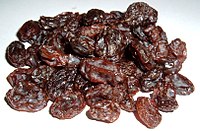| Revision as of 12:40, 2 May 2005 editMav (talk | contribs)Extended confirmed users77,874 editsm Reverted edits by 202.63.58.203 to last version by 80.186.248.122← Previous edit | Revision as of 22:53, 4 May 2005 edit undo62.252.128.25 (talk)No edit summaryNext edit → | ||
| Line 6: | Line 6: | ||
| In the ], the term 'raisin' refers to any form of dried grape. ] raisins – both the sun-dried dark naturals and the goldens – are made by drying Thompson seedless grapes; goldens are flame dried. Another variety of seedless grape, the ], is also sun dried to produce ]s, mini raisins that are much darker in colour and have a tart, tangy flavour. In ] and other countries specific varieties are given separate names (see ], ]). In particular, in Australia raisins are largest, sultanas are intermediate, while currants are smallest. | In the ], the term 'raisin' refers to any form of dried grape. ] raisins – both the sun-dried dark naturals and the goldens – are made by drying Thompson seedless grapes; goldens are flame dried. Another variety of seedless grape, the ], is also sun dried to produce ]s, mini raisins that are much darker in colour and have a tart, tangy flavour. In ] and other countries specific varieties are given separate names (see ], ]). In particular, in Australia raisins are largest, sultanas are intermediate, while currants are smallest. | ||
| Raisins are also produced in ] especially in the areas of ], ] and smaller islands. The main variety used in the Greek raisin is Sultanas. The grapes are mostly sun-dried thus producing seedless raisins of average size and golden color. A notable exception to this rule is the grape variety cultivated especially for the purpose of raisin production in ] that give darker and bigger type of raisin named Corinthian. Corinthian raisins are not seedless. | |||
| ==External links== | ==External links== | ||
Revision as of 22:53, 4 May 2005
Alternative uses: Raisin (disambiguation)

A raisin is a sun-dried or artificially dried grape. Raisins are either eaten raw or are used in cooking and baking. Raisins are extremely sweet due to their high sugar content, and if they are stored for a long period the sugar crystallises inside the fruit. This makes the fruit gritty, but does not affect the usability. To decrystalise raisins, they can be soaked in liquid (alcohol, fruit juice or boiling water) for a short period, dissolving the sugar.
In the U.S., the term 'raisin' refers to any form of dried grape. California raisins – both the sun-dried dark naturals and the goldens – are made by drying Thompson seedless grapes; goldens are flame dried. Another variety of seedless grape, the Black Corinth, is also sun dried to produce Zante currants, mini raisins that are much darker in colour and have a tart, tangy flavour. In Australia and other countries specific varieties are given separate names (see sultana, currant). In particular, in Australia raisins are largest, sultanas are intermediate, while currants are smallest.
Raisins are also produced in Greece especially in the areas of Peloponessus, Crete and smaller islands. The main variety used in the Greek raisin is Sultanas. The grapes are mostly sun-dried thus producing seedless raisins of average size and golden color. A notable exception to this rule is the grape variety cultivated especially for the purpose of raisin production in Corinth that give darker and bigger type of raisin named Corinthian. Corinthian raisins are not seedless.
External links
- Raisins — from Cooking.com